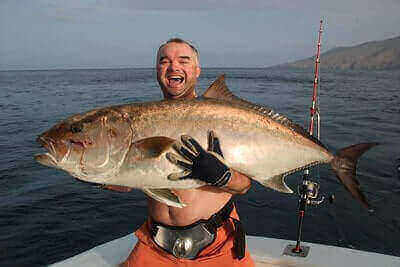Disclosure: We may earn commissions if you purchase products after clicking on a link from our site.
Are you interested in fishing for amberjack? Do you want to learn how to catch amberjack? Amberjack is a popular gamefish for anglers as it is large, powerful, and fights hard when hooked. It is usually near the bottom where it preys on small baitfish. In this article, we discuss the fishing techniques to catch amberjack, the baits and lures to use, as well as the equipment needed to catch this fish.
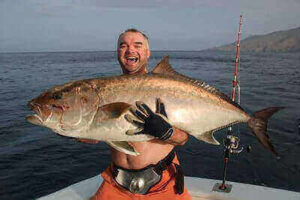
Table of Contents
- 1 How To Catch Amberjack
- 2 Amberjack Tackle
- 3 How To Catch Amberjack In The Gulf
- 4 How To Catch Amberjack In Texas
- 5 How To Catch Amberjack In Louisiana
- 6 How To Catch Amberjack In Pensacola
- 7 How To Catch Amberjack From Shore
- 8 Best Amberjack Bait
- 9 Best Amberjack Lures
- 10 How To Catch Amberjack From Shore
- 11 Amberjack Fishing Tips
- 12 The Bottom Line
How To Catch Amberjack
1. Bottom Fishing
Bottom fishing is a popular and effective technique for targeting amberjack, sturdy and powerful fish found in offshore waters. Anglers typically anchor or drift over underwater structures such as reefs, wrecks, or rock formations where amberjack congregate.
Using heavy-duty tackle and strong lines, anglers drop baited hooks to the seabed, where amberjack often patrol in search of prey. Common baits for bottom fishing include live baitfish, such as blue runners or mullet, as well as cut bait like squid or bonito.
Once a fish takes the bait, anglers must quickly set the hook and employ strong, steady pressure to prevent the amberjack from reaching the safety of the structure. Bottom fishing for amberjack requires patience, skill, and stout equipment to handle the powerful runs and deep dives characteristic of these hard-fighting game fish.
Since amberjacks are bottom feeders, you want to use the bottom fishing technique to catch them. Drop your line to the bottom of the water where you found structures and wait for bites. When you get bites, hook the fish and reel it in. You want to reel amberjacks to the surface as fast as possible as sharks are attracted to struggling amberjacks and will come to get it if you don’t get the amberjack into your boat quickly.
2. Trolling
Trolling is a popular fishing technique utilized to target amberjack, especially in offshore waters. Anglers employ this method by trailing lines with lures or baited hooks behind a moving boat at varying speeds. The primary objective is to cover a large area of water to locate schools of amberjack.
Trolling allows anglers to present their lures or baits at different depths and distances from the boat, increasing the likelihood of enticing strikes from these powerful fish. Common trolling setups for amberjack include using diving plugs, skirted lures, or natural baits such as live baitfish or strips of squid.
The key to successful trolling for amberjack is to vary the speed and direction of the boat while keeping a close eye on the depth finder for signs of fish or underwater structure. When a strike occurs, anglers must quickly reel in the line to set the hook and then engage in a battle to land the strong and determined amberjack.
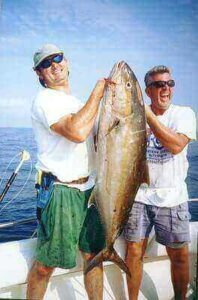
3. Jigging
Jigging is a highly effective fishing technique used to target amberjack, particularly around offshore reefs, wrecks, and underwater structures where these fish commonly congregate. Anglers employ this method by vertically dropping heavy metal jigs to the desired depth and then jerking the rod upwards in a sharp motion to imitate the movement of injured baitfish.
This action attracts the attention of amberjacks, known for their aggressive feeding behavior, prompting them to strike the jig. Jigging requires precise control over the movement of the lure, with anglers varying the speed and rhythm of their jigging motion to entice bites.
Successful jigging for amberjack often involves locating productive spots using fish finders or knowledge of underwater topography, then carefully working the jig through the water column to elicit strikes. When a strike occurs, anglers must quickly set the hook and engage in a challenging battle to reel in these powerful and hard-fighting fish.
Amberjack Tackle
Amberjack is a large and powerful fish that will fight very hard when hooked to break the line. As a result, you need a very strong line that can withstand the punishment it will take from an amberjack.
Depending on your fishing style and techniques, you can use a conventional or spinning reel. The fishing rod should support lines that can carry 60 to 80-pound lines. Use braided or monofilament lines as the counter pull from the fish can break the fishing line.
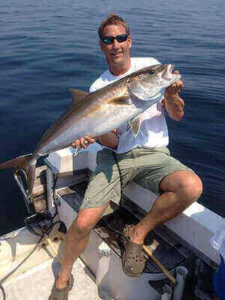
How To Catch Amberjack In The Gulf
Amberjacks eat anything they can get. Shrimp, crabs, squid, small fish, and crustaceans can be used as bait. They are often found around structures such as wrecks, reefs, and oil rigs. When fishing for Amberjack in the Gulf of Mexico, bottom fishing, jigging, and trolling are some of the fishing methods often used.
When you find structures or spot jacks on your fish finder, drop your line to the bottom or to the depth where they are located and wait for a bite. When trolling, anglers will set the line at the back of the boat and as the boat moves, the bait will move through the water. This will get the attention of the fish and might encourage it to go for the bait.
How To Catch Amberjack In Texas
Amberjacks are usually found around reefs, oil platforms, and shipwrecks. A fish finder is often used by anglers to find areas where Amberjacks may be hanging out. Squid, crabs, small fish, and shrimp are baits that are used when fishing for jacks.
Most anglers use trolling, bottom fishing, or jigging when fishing for Amberjacks. Both bait and lures can be used when fishing for Amberjacks.
How To Catch Amberjack In Louisiana
In Louisiana, Amberjacks can be found near artificial reefs, oil platforms, shipwrecks, and other structures. They hang around those structures as they wait to ambush their prey. Squid, shrimp, small fish, crabs, and other crustaceans are what they feed on.
When you see any of these structures, drop your bait close to them to entice Amberjacks to bite. Trolling, jigging, and bottom fishing are some of the fishing methods used when fishing for Amberjacks.
How To Catch Amberjack In Pensacola
Amberjacks are often found around structures like shipwrecks, oil platforms, and artificial reefs. Look for these structures on your fish finder. After spotting some, drop your bait very close to them to get a bite from amberjacks. Amberjacks are aggressive and a good presentation increases your chances of getting a bite.
Additionally, bait and lures can be used when fishing for amberjacks, although live bait works the best. Shrimp, crabs, squid, and small fish are often used when fishing for amberjacks in Pensacola. Bottom fishing, trolling, and jigging are some of the fishing methods often used by anglers.
How To Catch Amberjack From Shore
When fishing for amberjack from the shore, it is good to look for areas with an elevation that you can fish from. Study the water to find any areas where amberjacks may be found. A castable fish finder can help you when fishing from the shore. Drop your bait into the water and let it hit the bottom. Then jig it a little to entice the fish to go for a bite. You may catch other fish as well.
Small baitfish, crabs, shrimp, and squid can be used when fishing for amberjack from the shore. Lures can also be used. Bottom fishing, trolling, and jigging are fishing methods often used to catch amberjack.
Best Amberjack Bait
1. Squid
Squid is a popular and effective bait choice for targeting amberjack in both recreational and commercial fishing. Its firm texture and strong scent make it highly attractive to these voracious predators. Anglers often use whole or cut squid as bait, either fresh or frozen, depending on availability and preference.
When fishing for amberjack, squid can be rigged onto hooks using various methods, such as threading it onto a jig head, hooking it through the mantle, or impaling it onto a circle hook. The presentation of squid as bait can vary based on the fishing conditions and the angler’s strategy, with some opting for suspended baits while others prefer bottom fishing rigs.
Regardless of the rigging method, squid appeals to the carnivorous instincts of amberjack, enticing them to strike and providing anglers with thrilling battles once hooked.
2. Shrimp
While shrimp is not typically the primary choice of bait for targeting amberjack, it can still be effective under certain conditions. Amberjack are opportunistic feeders known for their aggressive behavior, and they will often strike at a variety of baits.
Shrimp, particularly larger specimens, can attract the attention of hungry amberjack, especially when presented in areas where they are known to inhabit. Anglers may use whole shrimp or pieces of shrimp on hooks, either fresh or frozen, to entice these fish.
However, due to the size and strength of amberjack, anglers often opt for more substantial baits such as live baitfish or squid. Nonetheless, using shrimp as bait for amberjack fishing can still yield success, particularly when other bait options are scarce or when targeting smaller individuals within a school.
3. Small crabs
Small crabs can be excellent bait for targeting amberjack, particularly when these fish are foraging near the ocean floor or around structure such as wrecks and reefs. Amberjack have a voracious appetite and are known to feed on a variety of crustaceans, including crabs.
Live or freshly killed small crabs, such as blue crabs or fiddler crabs, can be rigged onto fishing hooks and dropped down to where the amberjack is holding. The natural movement and scent of the crab can attract the attention of these powerful predators, enticing them to strike.
Anglers often employ a bottom fishing technique when using crab bait for amberjack, allowing the bait to reach the desired depth where the fish are actively feeding. While other bait options like squid or baitfish are commonly used for amberjack, small crabs can be particularly effective in enticing these fish, especially when presented in areas known to hold amberjack populations.
4. Pinfish
Pinfish are a popular bait choice for anglers targeting amberjack, especially in regions where these fish are prevalent. These small, silvery fish are abundant in coastal waters and are known to inhabit a variety of habitats, including reefs, wrecks, and rocky structures where amberjack often congregate.
Their natural swimming motion and scent make them highly attractive to predatory species like amberjack. Anglers typically rig live or freshly caught pinfish on sturdy fishing hooks and present them near the bottom or at mid-depths using various fishing techniques such as bottom fishing or vertical jigging.
Pinfish can be particularly effective when fished around structures where amberjack is known to hold, as they mimic the natural prey of these powerful fish. Overall, pinfish serve as versatile and effective bait for targeting amberjack, offering anglers a reliable option to entice these prized gamefish.
5. Mackerel
Mackerel is widely recognized as one of the most effective baits for targeting amberjack, prized gamefish known for their powerful fights and impressive size. These oily and flavorful fish are naturally appealing to amberjack due to their strong scent and lively swimming action.
Anglers often use fresh or frozen mackerel as bait, either whole or in chunks, to entice hungry amberjack. When rigged properly on sturdy hooks, mackerel can withstand the strong strikes and aggressive feeding behavior of these formidable predators.
Whether deployed near reefs, wrecks, or other structure-rich areas where amberjack is commonly found, mackerel can attract these fish from a distance and trigger aggressive strikes. Their versatility and effectiveness make mackerel a go-to bait choice for anglers seeking to hook into trophy-sized amberjack.
6. Blue Runner
Blue Runner, also known as Hardtail, is a popular bait choice for anglers targeting amberjack. These sleek, fast-swimming fish are prized for their lively action and strong scent, making them irresistible to predatory species like amberjack.
Blue Runners are commonly used live or fresh-dead, rigged on sturdy hooks to withstand the powerful strikes of these aggressive gamefish. Their shiny, silver scales and darting movements mimic the appearance and behavior of natural prey, making them highly effective in enticing strikes from large amberjacks.
Whether fished near reefs, wrecks, or other structure-rich areas where amberjack congregate, Blue Runner baits can attract these powerful predators and result in thrilling battles for anglers seeking trophy-sized catches.
7. Sardines
Sardines are a versatile and effective bait choice for anglers targeting amberjack. These oily, silver-colored fish are known for their strong scent and natural swimming action, making them highly attractive to predatory species like amberjack.
Anglers often use fresh or frozen sardines rigged on heavy-duty hooks to withstand the powerful strikes of these hard-fighting fish. Whether fished whole or cut into chunks, sardines emit a potent scent trail in the water, drawing in hungry amberjack from a distance.
Their shiny scales and lifelike movements make them irresistible to these voracious predators, particularly when presented near reefs, wrecks, or other structure-rich areas where amberjack is commonly found. Overall, sardines are a reliable bait option for anglers seeking to hook into the prized amberjack species.
8. Octopus
Octopus is a lesser-known but highly effective bait for targeting amberjack. Its tough texture and strong scent make it appealing to these voracious predators. Anglers often use octopus tentacles or whole octopus as bait, either fresh or frozen.
Octopus is particularly effective when fishing around rocky bottoms or reefs where amberjack is known to congregate. Its natural movement and scent can entice even wary fish to strike, making it a valuable addition to the angler’s arsenal.
When rigging octopus as bait, anglers typically secure it to a heavy-duty hook using a variety of methods, ensuring it stays intact during powerful strikes. Overall, octopus is a versatile and reliable bait choice for anglers targeting the formidable amberjack.
9. Cigar Minnows
Cigar minnows are a popular and effective bait choice for anglers targeting amberjack. These small fish have a slender body and a shiny silver coloration, making them a natural prey item for many predatory species, including amberjack.
Anglers often use cigar minnows whole or cut into chunks, depending on the size of the fish they are targeting. When rigging cigar minnows as bait, anglers typically hook them through the lips or back to allow for natural movement in the water.
Additionally, cigar minnows can be fished live or dead, depending on the angler’s preference and the fishing conditions. Overall, cigar minnows are prized for their durability, availability, and ability to attract the attention of hungry amberjack, making them a go-to bait option for many anglers.
10. Mullet
Mullet is a versatile and effective bait choice for anglers targeting amberjack. These baitfish are commonly found in coastal waters and are known for their strong, oily scent, which can attract predatory species like amberjack from a distance.
Anglers typically use mullets either whole or cut into chunks, depending on the size of the fish they are targeting and the fishing conditions. When rigging mullets as bait, anglers often hook them through the lips or back to allow for natural movement in the water.
Mullet can be fished live or dead, and their large size makes them particularly appealing to larger predatory fish like amberjack. Overall, mullet’s natural scent and size make it a reliable bait option for anglers seeking to hook into these powerful and prized gamefish.
11. Menhaden
Menhaden, also known as bunker or pogies, are a popular bait choice for anglers targeting amberjack. These oily and robust baitfish emit a strong scent that can attract predatory species from a distance.
Menhaden are often fished live or as cut bait, depending on angler preference and the fishing conditions.
When rigged as bait, anglers typically hook menhaden through the lips or back to allow for natural movement in the water. Their oily flesh and large size make them particularly appealing to larger predatory fish like amberjack, which are known for their aggressive feeding behavior. Overall, menhaden is a reliable bait option for anglers seeking to entice these powerful gamefish.
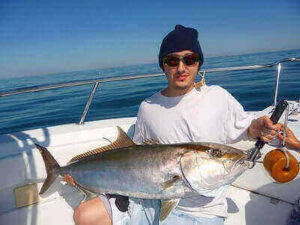
Best Amberjack Lures
1. Metal Jigs
Metal jigs are highly effective lures for targeting amberjack, prized for their aggressive strikes and powerful fighting abilities. These jigs come in various shapes, sizes, and colors, allowing anglers to match the baitfish species present in the area or experiment with different presentations to entice strikes.
The erratic darting action of metal jigs mimics wounded or fleeing baitfish, attracting the attention of hungry amberjack lurking near the bottom structure. Anglers typically deploy metal jigs by jigging them up and down vertically or casting them out and retrieving them rapidly through the water column.
The flashy and erratic movement of metal jigs triggers the predatory instincts of amberjack, making them a go-to lure choice for anglers targeting these hard-fighting gamefish.
2. Spoons
Spoons are versatile lures that can be highly effective for targeting amberjack. These lures feature a shiny, reflective surface that mimics the appearance of baitfish, attracting the attention of predatory species like amberjack.
Anglers typically cast spoons out and retrieve them at various speeds, allowing the spoon’s fluttering action to imitate a wounded or fleeing baitfish. Additionally, spoons can be jigged vertically near the bottom structure, where amberjack often lurks in search of prey.
The erratic movement and flash of spoons make them irresistible to amberjack, prompting aggressive strikes. Anglers can choose from a variety of spoon sizes, shapes, and colors to match the local baitfish species and water conditions, increasing their chances of success when targeting these powerful gamefish.
3. Jerkbaits
Jerkbaits are a popular choice among anglers targeting amberjack due to their lifelike swimming action and versatility. These lures typically feature a slender profile with a long, narrow body and a diving lip, allowing them to dive to specific depths and imitate the movements of injured baitfish.
Anglers can employ a twitching or jerking retrieve technique to impart erratic movements to the jerkbait, simulating the actions of a wounded prey fish. This erratic action is particularly effective in triggering predatory strikes from aggressive amberjacks.
Jerkbaits come in various sizes, colors, and diving depths, allowing anglers to match the lure to the prevailing conditions and the behavior of the fish. Whether cast and retrieved or trolled behind a boat, jerkbaits can be a productive option for anglers seeking to hook into hard-fighting amberjack.
4. Plastics
Plastic lures, including soft plastic swimbaits and paddle tails, are effective options for targeting amberjack in various fishing conditions. These lures come in a wide range of sizes, shapes, and colors, allowing anglers to match the hatch or experiment with different presentations to entice strikes.
Soft plastics mimic the appearance and movement of baitfish, making them highly attractive to predatory species like amberjack. Anglers can rig soft plastics on jig heads or weighted hooks to achieve the desired depth and action. Whether retrieved with a steady retrieve, hopped along the bottom, or worked through the water column with erratic twitches, plastic lures can provoke aggressive strikes from amberjack.
Additionally, their durability ensures that anglers can fish them through multiple strikes without needing frequent replacements, making them a cost-effective and practical choice for targeting these powerful game fish.
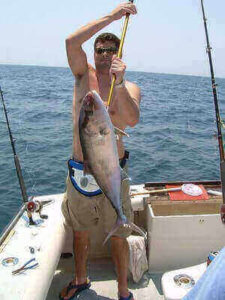
How To Catch Amberjack From Shore
When fishing for amberjack from the shore, look for any structures and send your line down to get bites from amberjacks. When you get a bite, reel in the fish quickly. A spinning reel is a good option when fishing from the shore to help quickly reel in the fish.
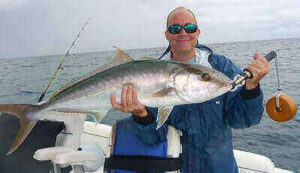
Amberjack Fishing Tips
1. Live bait is the best bait to use when fishing for amberjacks.
2. Amberjacks can be found around structures like reefs, shipwrecks, and oil rigs.
3. Amberjacks are bottom dwellers. Hence, you want to fish close to the bottom of structures, about 60 feet deep.
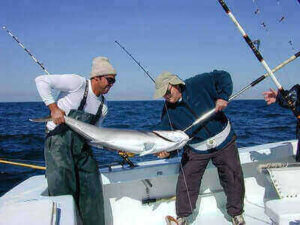
4. Bottom fishing and trolling are fishing techniques used to catch amberjacks.
5. Amberjack is a type of jackfish found in the Gulf of Mexico.
6. Amberjack is usually found close to the bottom of waters in depths from 60 to 300 feet.
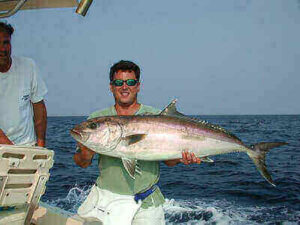
7. Amberjack spawn in spring.
8. You don’t need wire leaders as amberjack doesn’t have teeth.
9. Amberjack is a tasty fish but is known to carry parasitic worms in its flesh. In some areas, the amberjack is also known to carry ciguatera toxin.
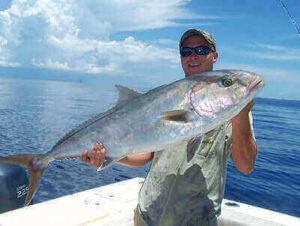
10. Spring and summer are the best times to fish for amberjacks.
11. Always set the drag preset to match your strength and that of your equipment to prevent your equipment from getting broken.
12. Amberjacks get excited pretty easily and will swim to the surface where you can use plugs and other baits to catch them.
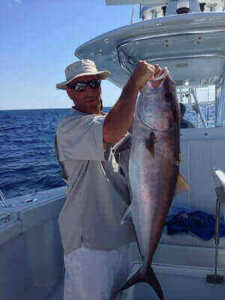
13. When you fish for amberjacks near coral reefs, adjust the lead until the bait is positioned midway in the water column. They swim above coral reefs making it the best place to have your bait.
14. Trolling, bottom fishing, and jigging are some of the fishing techniques used to catch amberjack.
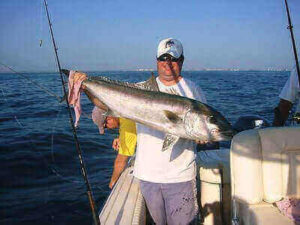
15. Always use circle hooks when fishing for amberjack.
16. Always use braided or monofilament lines as the counter pull from the amberjack can break the line if it is not braided or monofilament line. Braided lines cut through ocean currents better and can drag out amberjack from deep waters over long distances.
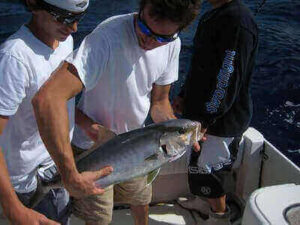
The Bottom Line
Amberjack is a popular gamefish for anglers as it grows to be large and will put up a hard fight when hooked. It can be found in the Gulf of Mexico. Using the right equipment to catch amberjack is very important to successfully catch this fish as it is very strong and heavy.
In this article, we discussed the fishing techniques, the equipment needed, amberjack fishing tips, baits, and lures to help you catch this very strong fish. If you are also interested in other fishes like Mahi Mahi, marlin, and largemouth bass, then read the articles on how to catch marlin, how to catch largemouth bass, and how to catch Mahi Mahi.
